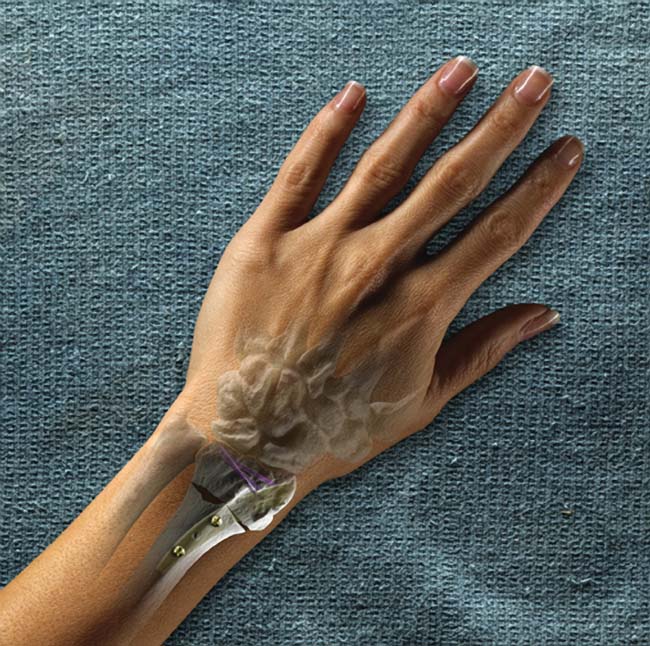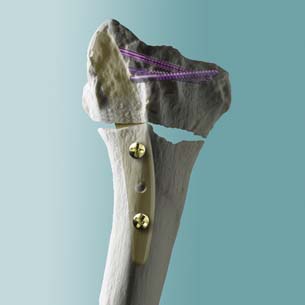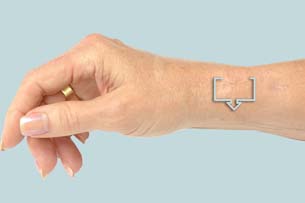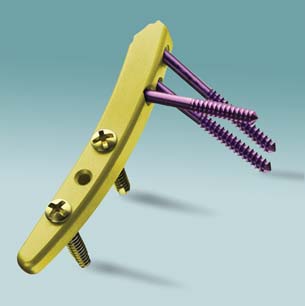Fast App: Siemens Teamcenter Drives Competitive Advantage Through PLM
Latest News
February 1, 2010
By DE Editors
An orthopedic medical device provider has implemented Siemens PLM Sofware’s NX and Teamcenter to achieve greater innovation and product development speed, and ensure strict compliance with industry and government mandates.
 Figure 1. Before Teamcenter, Wright Medical had to send the doctor a rapid prototype model, which the doctor would send back, with markings explaining how to modify it. Now the doctor can look at a 3D animation set up in Teamcenter, reducing a three-day turnaround to a couple of hours. |
Wright Medical Technology Inc. is a global orthopedic medical device company, specializing in the design, manufacture, and marketing of reconstructive joint devices and biologics. Its products include large-joint implants for the hip and knee; extremity implants for the hand, elbow, shoulder, foot, and ankle; and both synthetic and tissue-based bone graft substitute materials. Headquartered in Arlington, TN, the company has been in business for more than 50 years, has approximately 1,000 employees, and is listed on the Nasdaq Global Select Market under the symbol WMGI.
 Figure 2. NX enables Wright Medical to easily change the size of the MICRONAIL design as needed because everything updates automatically. In addition, the designer can ensure parts fit together in context and to virtually visualize the finished product before it is actually produced. |
With a commitment to evolving medical breakthroughs in the field of orthopedics, Wright management saw an opportunity to think bigger and push the envelope of innovation, quality, and compliance by investing in product lifecycle management (PLM) technology—NX software and Teamcenter platform—from Siemens PLM Software.
Wright uses Siemens’ solutions for product development, data and medical records management, collaboration, compliance, traceability, and reporting, including using the software to meet FDA regulatory requirements.
An example of Wright’s applying PLM for innovation is demonstrated in its use of NX. “The distal radius is the forearm bone on the thumb side, and it’s the most commonly fractured bone,” says Penny Rasmussen, Marketing Manager for the MICRONAIL project. “Wright had a goal to make a less invasive, less painful way to repair this common fracture. And that solution was the MICRONAIL Intramedullary Fixation Implant. NX helped Wright bring that product to the market in record time.”
Visualization and Collaboration
According to Chad Schwartz, lead design engineer, MICRONAIL project, Wright Medical Technology, the assembly package for NX enables the company to use the implant to design instruments for ease of development and change. “As far as different sizes for implants or something the doctor wants changed, it’s easy to do because everything updates succinctly,” says Schwartz. “NX is the most powerful design software I’ve ever used. The solid models, the assemblies, all of the things that come together in the modeling aspect produce better results. You can see things fit together in a way that you can’t do in other software. You see your finished product before it’s actually a finished product.”
Teamcenter extends the company’s ability to flourish. “Teamcenter allows Wright to be more competitive in the marketplace by allowing manufacturing, engineering, quality, and marketing all to work in parallel with one another,” says Schwartz. “That means saving time, getting our product on the market in a faster manner, and beating the competition more often than not. Teamcenter is probably the best thing that’s happened to Wright, as far as bringing everything together and making it all one. The time savings alone are worth it. Instead of having to go and find the right design data file in the file cabinet, you have everything right there at your fingertips.”
 Figure 3. The distal radius, the forearm bone on the thumb side, is the most commonly fractured bone. So Wright Medical set a goal to create a less invasive, less painful way of repairing these fractures. |
While data re-use is important, collaboration is critical. Schwartz points out, “Before Teamcenter, we had to send the doctor a rapid prototype model. The doctor would send it back to us, with markings, and tell us how to change it. Now the doctor can look at our model as we rotate it, or maybe an animation that we set up in Teamcenter. We get quicker response. Instead of maybe a three-day turnaround, we’ve got it down to a couple of hours.” In addition, he notes, “Our distributors throughout the country can log on and look at what we’re designing right then. Show a doctor what’s coming. And they can decide right then whether or not they’d like to use it.”
As new products are developed and manufactured, Wright has expanded the use of Teamcenter to manage all kinds of engineering specifications in a single platform. This includes gradually achieving the company’s objective of an electronic device medical record.
Compliance
Complying with FDA regulations represents another important area where an advantage gained can be significant in terms of turnaround, especially as regulations are prone to change often in the medical industry. In fact, Wright has dramatically enhanced the availability of compliance data and reduced the time it takes to access that data. Previously, a process that was paperwork intensive—sometimes taking days, weeks, or even months—device history is now immediately available. Using Teamcenter, Wright can access the information with a few clicks.
 Figure 4. Wright Medical used the NX digital design and Teamcenter digital lifecycle management solutions from Siemens PLM Software to design and produce the MICRONAIL Intramedullary Fixation Implant and bring it to market in record time. |
Performance
Wright moved to a product-centric system not just to improve innovation, speed, and compliance on the front end of the process, but because products need to last the lifecycle of their patients, which can be decades. The company’s approach to orthopedic medical device delivery—strategically, operationally, and technologically—is proving to be quite effective.
Moreover, Wright’s financial performance is strong. “We’re growing,” says Rasmussen. “We’re increasing our market share every year. It has a lot to do with the systems that we run. Teamcenter being the main one.”
Business Challenges
• Speed and confidence in designing and producing orthopedic devices
• Compliance with FDA and other applicable requirements
• Ability to continually innovate
• Effective management of product and process data
Keys to Success
• NX for digital product development
• Teamcenter for digital data management
• Data access/re-use across decades
• Virtual prototyping
• Collaboration across departments, distributors, and customers
Results
• Wright’s MICRONAIL Intramedullary Fixation Implant brought to market in record time
• More efficient design turnaround
• Typical design approval time reduced from days to hours
• Compliance data that once took days, weeks, or even months to access now immediately available
More Info:
Siemens PLM Software
Subscribe to our FREE magazine, FREE email newsletters or both!
Latest News
About the Author
DE’s editors contribute news and new product announcements to Digital Engineering.
Press releases may be sent to them via [email protected].






